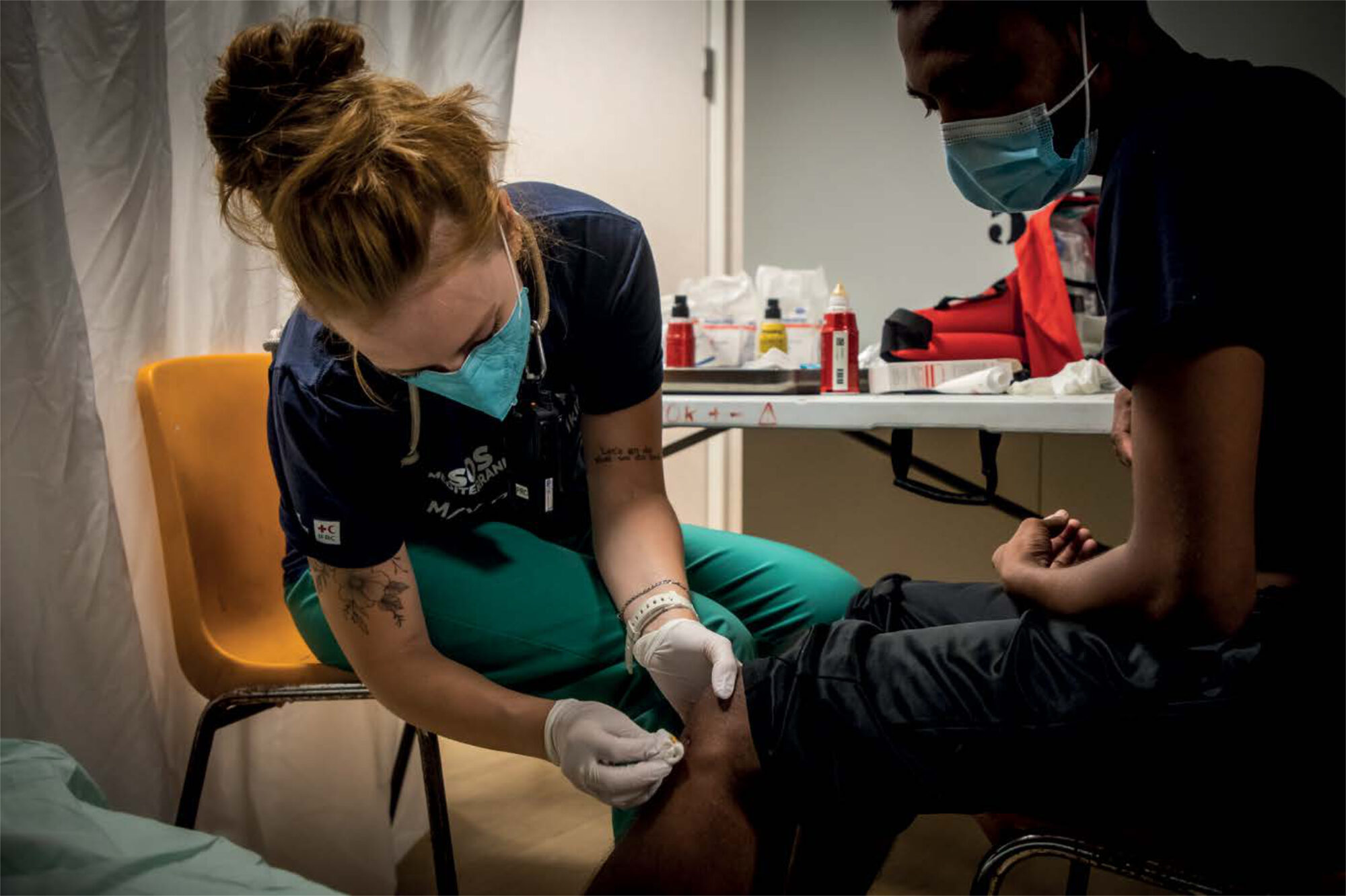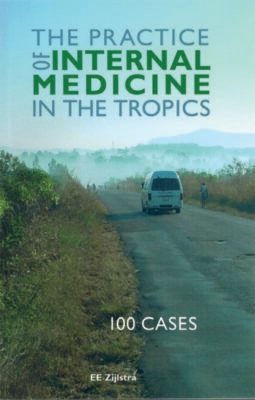Main content
The Central Mediterranean has become the focal point of a prolonged migration crisis, where thousands risk everything on the deadliest migration route in the world in search of safety in Europe. Many depart from Libya and Tunisia, facing the grim reality of overcrowded, unseaworthy vessels as they traverse hundreds of miles across the sea. This perilous journey often endangers lives, especially as European state-sponsored rescue efforts have diminished and funding has shifted to Libyan and Tunisian coastguards, leading to more dangerous pushbacks. As a result, civil Search and Rescue (SAR) operations have become even more essential for providing immediate, lifesaving assistance; over 14,000 people were rescued by SAR non-governmental organisations (NGOs) in 2023 alone.[1] Leading these efforts is SOS Méditerranée, founded in 2015, which operates the Ocean Viking—a vessel dedicated to saving lives in life-threatening situations at sea.[2]
In 2023, the migration crisis saw 157,651 migrants to Italy comprising 62 different nationalities, predominantly from Guinea, Tunisia, and Côte d’Ivoire. Among those rescued, 72% were male, 12% were unaccompanied children, 10% were women, and 5% were accompanied children.[3] Each demographic group faces distinct vulnerabilities in addition to the widespread physical and sexual violence experienced along the migration pathway; unaccompanied minors are particularly at risk of exploitation, women often encounter gender-based violence, and accompanied children endure the trauma of potential family separation. Men, too, face significant challenges, including exploitation, mental health issues stemming from trauma and isolation, and increased risks of violence and legal uncertainties during their migration journey.[4-6]
Health needs
The physical health needs of these individuals are often diverse and can be urgent. Common conditions include dehydration, hypothermia, heat-related illnesses, sea-sickness, and skin infections. Many also suffer from untreated chronic diseases such as diabetes and hypertension, complicating their care. Acute injuries—from trauma and burns to violence-inflicted wounds—underscore the harsh realities of their journeys. In 2023 alone, the Ocean Viking conducted over 1,250 individual medical consultations, with 276 survivors referred for further medical care on land.[7]
Many individuals arrive with unmet healthcare needs due to a lack of access during their journeys. Women commonly present with gynaecological issues related to sexual violence or exacerbated untreated conditions, and maternal healthcare is provided onboard due to the frequent inaccessibility of care along migration pathways and in countries of origin. Pregnant women often face emergencies onboard due to minimal antenatal care before embarkation as well as the extra stressors added to an already delicate physiological balance. Children require basic healthcare and can show signs of emotional distress but often thrive when cared for by compassionate individuals. Child well-being checks are vital for infants born along migratory pathways, as they are particularly vulnerable to health complications due to denial of access to necessary care.
Primary health needs are prevalent across all demographics, including untreated skin conditions that have escalated in the harsh realities of detention centres and generalised body pain resulting from the physical toll of their journeys. Each encounter reaffirms the importance of providing not only medical care but also the kindness and empathy that aim to restore dignity and hope—qualities often stripped away from those rescued at sea.
One case highlights the critical and varied nature of our work: a young man requested help from the rescue team, initially reluctant to draw attention to himself during the ongoing rescue. While he originally appeared to have burns from fuel exposure, further assessments revealed a much graver situation: he had escaped captivity in Libya by jumping from an upper-floor window, resulting in a fractured spine and severe burns after landing in a fire. While this case is extreme, it reflects a broader reality. Typically, individuals present with an array of minor conditions that have worsened due to prolonged neglect, but medical teams must be prepared to respond to extreme physical and psychological injuries stemming from the cruelty inflicted by other humans or from desperate attempts to flee such violence. A key role in these moments, in addition to providing essential medical care, is to rebuild trust not only in medical professionals but also in strangers, reassuring those rescued that compassion still exists, especially after significant trauma. Recovery involves addressing the immediate physical health needs while also providing psychological first aid, a vital aspect of humanitarian efforts. Survivors additionally often draw strength and support from one another, forming bonds of solidarity that help them navigate their shared experiences.
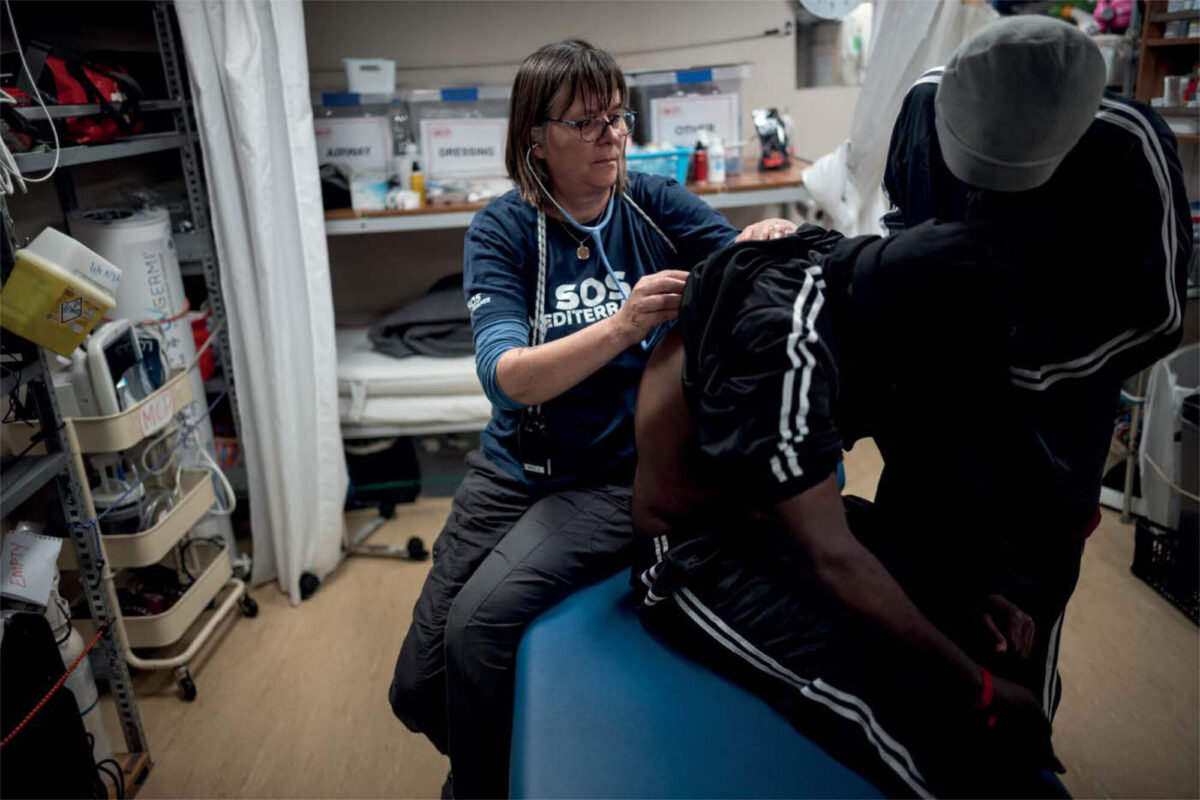
Medical resources
Medical resources on SAR vessels are essential for effective operations. While each ship has a unique team structure, the Ocean Viking is staffed by four medics: a medical doctor, a nurse, a midwife, and a medical team leader, whose clinical profile can be any of the previous three. The rescue ship is equipped with medications for both emergency and primary healthcare, along with resuscitation and stabilisation supplies, allowing them to serve as ‘ambulances of the sea’. As operations have evolved, provisions have been incorporated for longer-term medical treatment, particularly for chronic conditions exacerbated by delays in safe port assignments or extended transits.
Medical professionals play a crucial role not only in managing the influx of patients in this resource-limited environment through care provision, but also in the training of the wider crew to assist them when needed. All crew members receive training in basic life support and emergency protocols, which are vital when faced with overwhelming needs such as happened in March 2024, when a boat was encountered carrying individuals who had been at sea for over seven days. Many had already lost their lives, while the remaining survivors arrived in critical condition, with an extreme combination of exhaustion, dehydration, and hypothermia, necessitating a ship-wide mass casualty response.
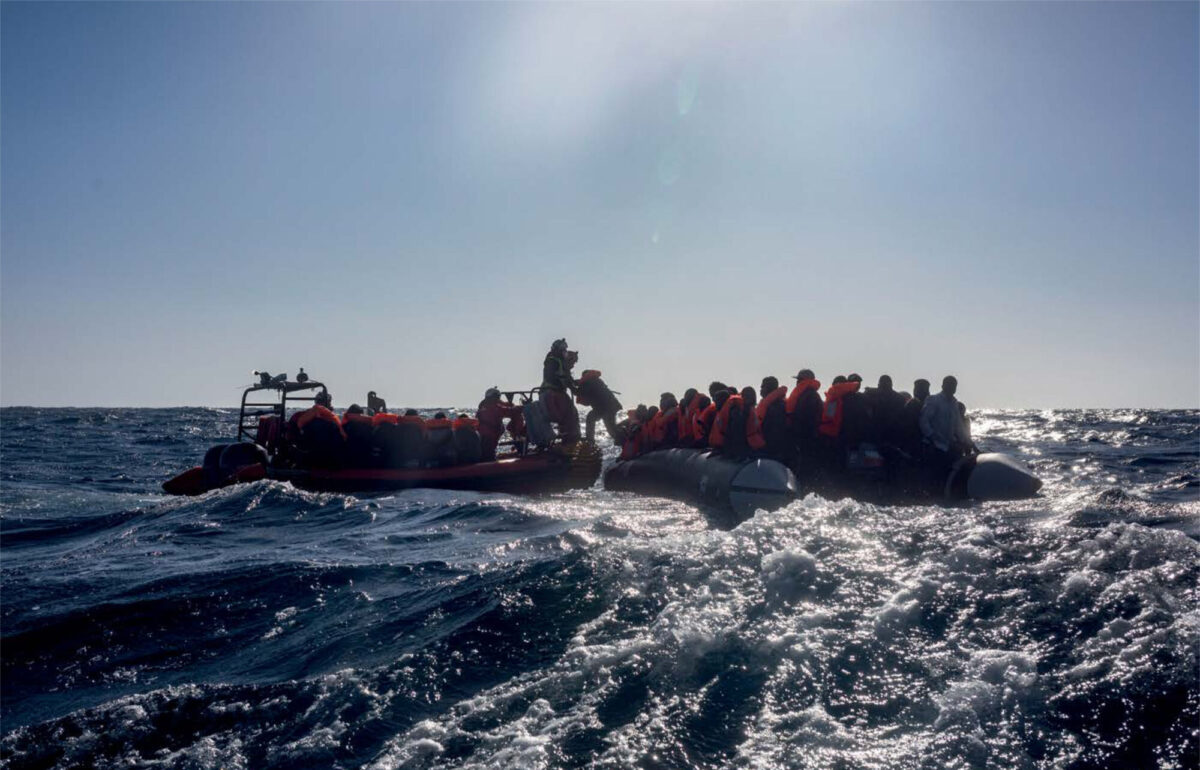
Upon rescue, standard operating procedures are implemented for assessing and triaging survivors. Initial evaluations determine whether individuals can walk and talk, and if there are any obvious emergent medical conditions. In exceptional mass casualty scenarios, a modified triage scale is employed to ensure that those in greatest need receive prompt care.[8,9] Infection control is also particularly important, given the heightened risk of disease in the overcrowded and unsanitary conditions many have been exposed to before being rescued.
Following rescues, medical teams begin to address the numerous health conditions present in survivors through a combination of in-depth clinical consultations and health promotion, along with expedited assessments conducted on deck. Logistically, providing care in a confined, moving environment presents significant challenges. Factors such as exposure to the elements, seasickness, and limited resources can exacerbate the vulnerabilities of those rescued. Advanced medical care is often constrained, and evacuation protocols for serious cases depend on national vessels or helicopters, heavily influenced by weather conditions and proximity to land, complicating timely assistance. Each operation highlights the critical need for adaptability as teams strive to meet the diverse health needs of those rescued.
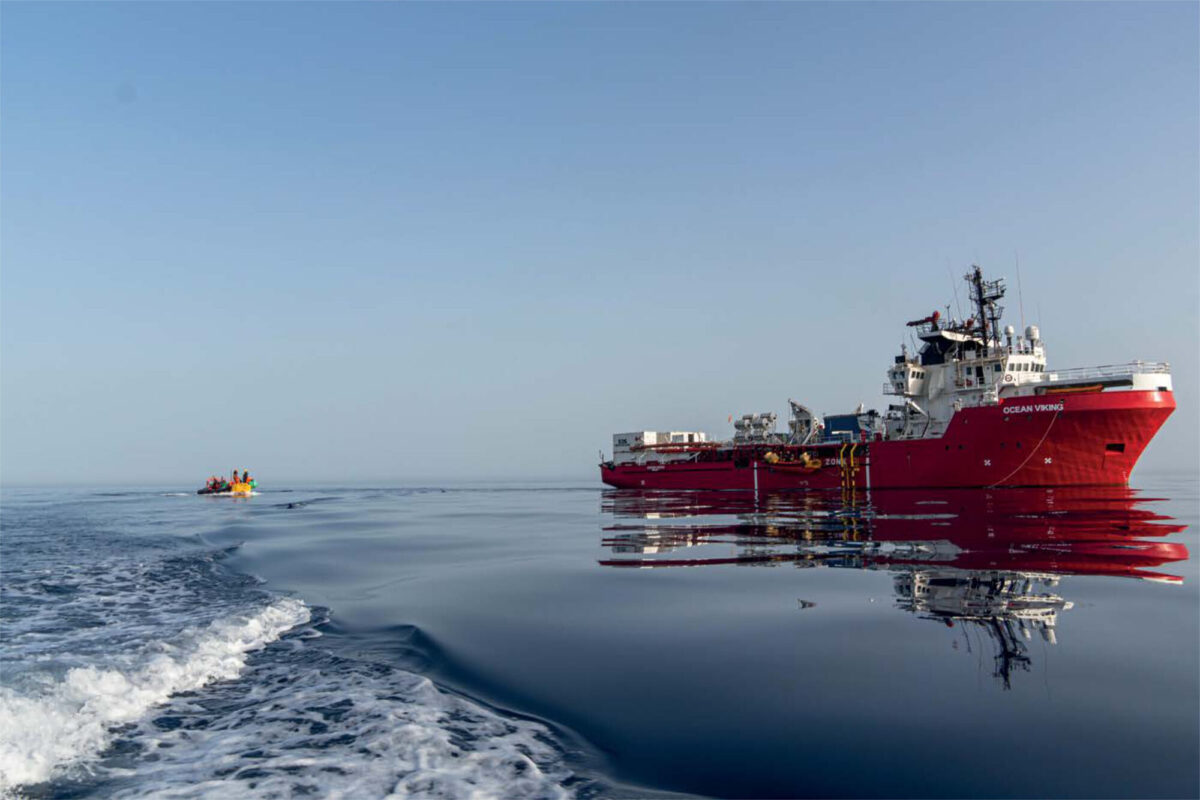
Discussion
Since 2014, over 30,396 people have tragically died while attempting to cross the Central Mediterranean—a number likely to be a grave underestimation due to significant gaps in data regarding departures.[10] This ongoing crisis is compounded by escalating violence against people seeking safety within North Africa and Europe, where individuals are increasingly viewed not as humans but as mere ‘numbers’ or ‘problems’.[11] Such dehumanisation undermines the fundamental rights of people on the move, who often face horrific conditions and treatment throughout their journeys. The humanitarian work of organisations like SOS Méditerranée and others operating in the Central Mediterranean goes beyond their legal obligation under international maritime law to save lives at sea and the fundamental human right to access healthcare. It seeks to restore dignity and recognise the humanity of those we serve whilst attempting to fill the critical gap in protection and assistance within the region.[11]
Each rescue mission emphasises the urgent need for a collective global response to ensure the well-being of the most vulnerable populations. SAR operations play a crucial role, focused primarily on saving lives, irrespective of an individual’s reasons for migrating. The medical and psychological needs of survivors are urgent and multifaceted, ranging from acute injuries and untreated chronic diseases to mental health challenges exacerbated by trauma and social isolation. Many survivors need to utilise an established mechanism for continuity of care via referral through Uffici di Sanità Marittima Aerea e di Frontiera (USMAF) when reaching land due to increased risk of morbidities.[5,12]
Safeguarding the rights of all individuals
The work on SAR vessels, staffed by dedicated healthcare and rescue professionals, is vital in addressing these varied health needs and fulfils a devastating gap left in the Central Mediterranean. These missions reinforce the importance of adaptability and resilience in the face of complex challenges. Each encounter with a survivor reveals their stories of resilience and strength, deepening our commitment to delivering effective healthcare amidst the chaos of migration and conflict. Ultimately, these experiences highlight the critical role we play in the lives of those seeking refuge and inspire a broader call for humanity to unite in safeguarding the rights, well-being, and access to care of all individuals, regardless of their circumstances.
https://www.sosmediterranee.org/contact-us/
References
- ReliefWeb. Migrant and refugee movements through the Central Mediterranean Sea in 2023 – Joint Annual Overview for 2023. [Internet]. Available from: https://reliefweb.int/report/tunisia/migrant-and-refugee-movements-through-central-mediterranean-sea-2023-joint-annual-overview-2023#:~:text=The%20majority%20of%20these%20arrivals,and%20Rescue%20(SAR)%20NGOs%20and. [Accessed 23 September 2024].
- SOS Méditerranée. [Internet]. Available from: https://www.sosmediterranee.org. [Accessed 7 October 2024].
- UNHCR. ITALY Sea Arrivals Dashboard. [Internet]. Available from: https://data.unhcr.org/en/documents/download/107239. [Accessed 22 September 2024].
- UNHCR. Global Trends: Forced Displacement in 2023. [Internet]. Available from: https://www.unhcr.org/global-trends. [Accessed 22 September 2024].
- WHO. Mental health of refugees and migrants: risk and protective factors and access to care. [Internet]. Available from: https://www.who.int/publications/i/item/9789240081840. [Accessed 22 September 2024].
- UNICEF. A Deadly Journey for Children: The Central Mediterranean Migration Route. [Internet]. Available at: https://www.unicef.org.uk/publications/deadly-journey-children-central-mediterranean-migration-route/#:~:text=”A%20deadly%20journey%20for%20children,across%20the%20sea%20to%20Italy. [Accessed 23 September 2024].
- IFRC. Central Mediterranean Sea: Population movement (HSP@Sea). [Internet]. Available from: https://go.ifrc.org/emergencies/5425/additional-info/data. [Accessed 7 October 2024].
- Clarkson L, Williams M. EMS mass casualty triage [Internet]. Treasure Island (FL): StatPearls Publishing; 2024 [updated 8 August 2023]. Available from: https://www.ncbi.nlm.nih.gov/books/NBK459369/. [Accessed 8 October 2024].
- NHS England. NHS Ten Second Triage Tool. [Internet]. Available from: https://www.england.nhs.uk/long-read/ten-second-triage-tool/. [Accessed 8 October 2024].
- Missing Migrant Project. Deaths during migration recorded since 2014, by region of incident. [Internet]. Available from: https://missingmigrants.iom.int/data. [Accessed 7 October 2024].
- UNHCR. UNHCR/IOM/MMC report highlights extreme horrors faced by refugees and migrants on land routes to Africa’s Mediterranean Coast. [Internet]. Available from: https://www.unhcr.org/uk/news/press-releases/new-unhcr-iom-mmc-report-highlights-extreme-horrors-faced-refugees-and-migrants. [Accessed 23 September 2024].
- Ministry of Health. What are the USMAF and what do they do. [Internet]. Available from: https://www.salute.gov.it/portale/usmafsasn/dettaglioContenutiUsmafSasn.jsp?id=3059&area=usmaf-sasn&menu=usmaf. [Accessed 8 October 2024].
















































